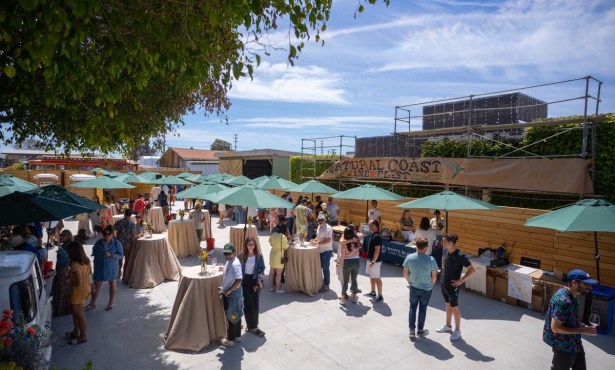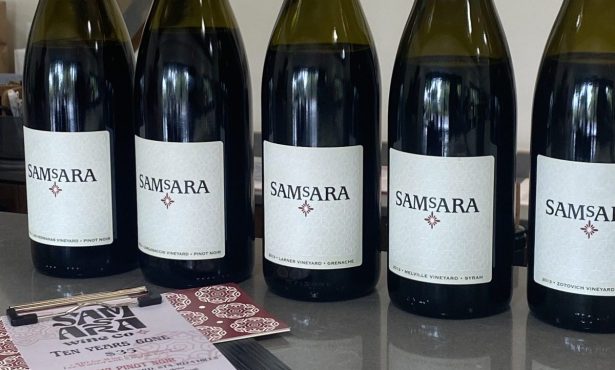Portfolio Envy
Brad Iwanaga Knows His Business
The Bradford Wine Group possesses one of the finest broker wine books in all of the Central Coast. Owned by Brad Iwanaga, the Bradford Wine Group boasts an impressive lineup of wineries in its small, select portfolio. Among its clients are The Hitching Post, Plumpjack Wines, and Rusack Vineyards. Located in downtown Santa Barbara, the Bradford Wine Group has brought to our local wine industry further credibility and clout. Iwanaga believes wholeheartedly in the expressed potential and excellence of Santa Barbara wineries, and his portfolio, which skews toward local wineries, is proof of his support and belief in local winemakers.
Iwanaga knows Santa Barbara County’s wine country so well that he served as a consultant on the film Sideways. Local restaurant owners and retailers consider the selection of wineries he represents to be “solid,” “some of the best in California,” and “hard to go wrong with.”
Iwanaga is affable, laid back, and fiercely intelligent when it comes to knowing how to steer a brand through the choppy waters of a highly competitive marketplace.
How long have you been a wine broker? I started my company in October 1985 when there were maybe five or six wineries operating in Santa Barbara County. Now, of course, there are probably close to 100. I’ve lost count.
In layman’s terms, what does a broker do? We contract with wineries and importers to represent their wines in a prescribed territory. In this case, it’s the tri-counties of the Central Coast. Our job is to approach restaurants and wine shops in an effort to promote and sell the wines from our suppliers. The process involves telling the stories behind the wines, tasting them, and ultimately we try to persuade our accounts to add the wines to their wine program.
When do you know that a wine has the “it” factor? In other words, what do you look for in a wine that you will ultimately represent? There are a number of ways that a wine or winery might be thrust into the industry spotlight. The press, of course-critics, wine and food writers, and dedicated publications-holds great sway over consumers. If the public is convinced, correctly or not, that a wine represents either a tremendous value or an example of exceptional quality, then that wine becomes highly sought. If it is a wine of limited production, then the ensuing frenzy is what “it” is all about.
I look for wines that represent diverse regions, have strong varietal character, and embody various winemaking styles. We seek different wines to appeal to the many varied palates and preferences. The bottom line is always quality winemaking and a pricing strategy that makes sense. From there, we put a great deal of faith in buyers and consumers to trust their own palates, and not necessarily rely on third-party endorsements.
Do you collect wines yourself? I’m a much better wine drinker than collector. I’ll lay wines down if I feel they have great potential to age and improve. But it’s very easy in my situation to amass more wine than I’ll ever be able to reasonably drink. Most of my long-term cellar is comprised of European wines and wines from the northeastern states. I’ll tend to drink California wines relatively early after release.
From your perspective, how has the Sideways phenomenon impacted wine sales? Is the Sideways phenomenon over, or is it continuing? Sideways has had a tremendous influence on the industry in general, and on the sales of pinot noir and Santa Barbara County wines specifically. In 20 years, I cannot remember a spike in demand for a single varietal like I’ve seen recently for pinot noir. The film compelled people to try pinot noir from producers that have been making great wine for years but were largely unappreciated. Now that people have “discovered” pinot noir, I think many will continue to enjoy it, and perhaps be more open in the future to trying other wines with which they are not as familiar. I suppose like everything else fashionable, the wine industry runs in cycles and trends. But I have no doubt that Sideways won many longtime fans for pinot noir and this area.
What is the best thing about being in the wine business? It’s a lifestyle-a lifestyle that embraces good food, good drink, and a sense of community. There is the inherent romance and a feeling of anticipation each year as we wait to see what is revealed with each new vintage. And it’s all set against the backdrop of a long historical perspective. Also, I have always loved the idea that wine represents an unusual combination of art and science, bringing together technical prowess and individual creativity.



